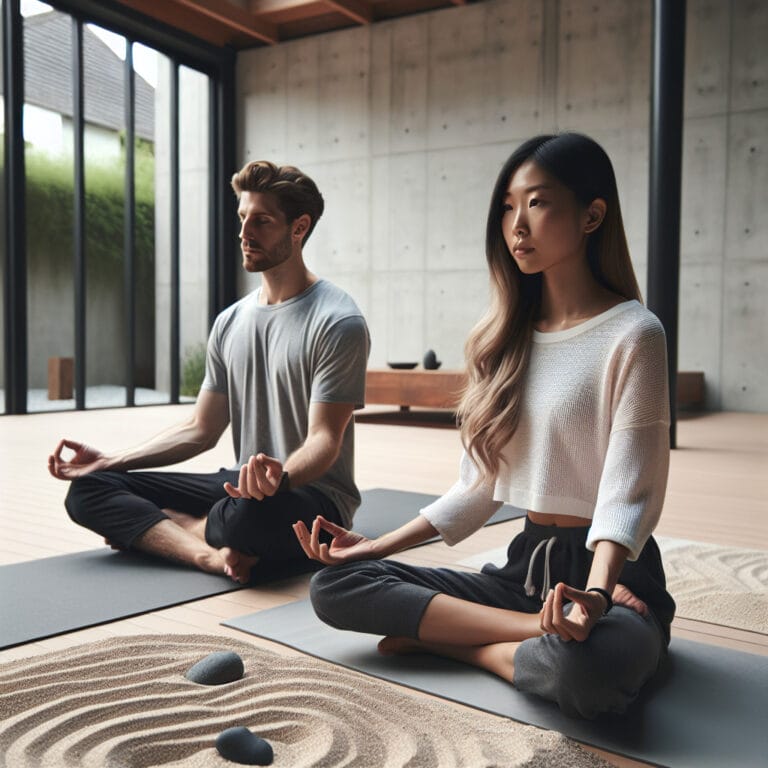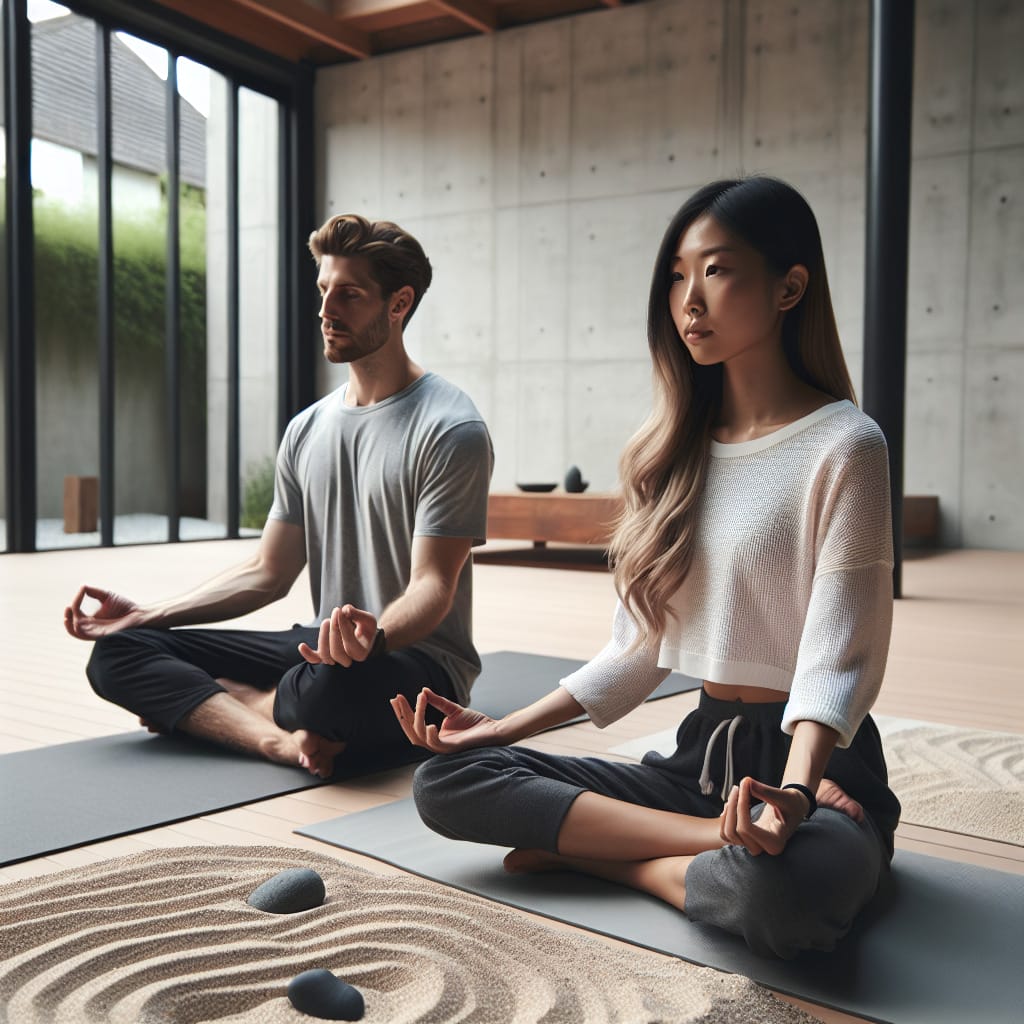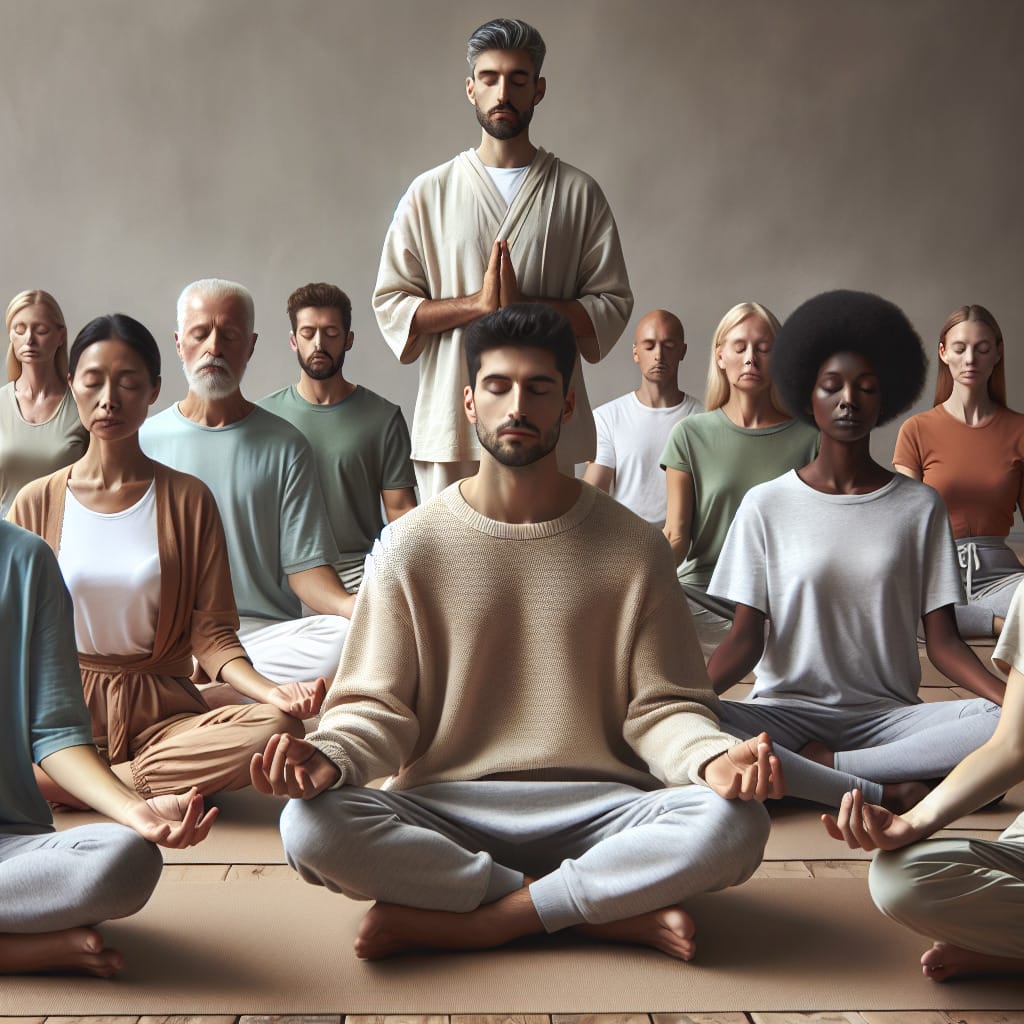
Mastering the Art: How to Lead a Guided Meditation Successfully
Table of Contents
- Introduction
- Understanding Guided Meditation
- Essential Skills for Leading a Guided Meditation
- Step-by-Step Guide to Leading a Guided Meditation
- Tips for Overcoming Common Challenges
- Conclusion
- Frequently Asked Questions
Introduction
A surprising fact about guided meditation is its transformative power on our minds and bodies. This mindfulness practice harnesses the synergy of mental visualization and relaxation techniques to create a unique meditative experience. It’s not just an introductory talk; it’s a journey into inner tranquility, led by the soothing cadence of an authentic voice keeping your mind from wandering while subtly guiding you through serene imaginary landscapes.
The importance of mastering the art of leading a guided meditation cannot be overstated as research underpins its impact on enhancing mindfulness exercises, releasing tension, and fostering emotional well-being. An effective leader maintains a calm relaxed tone during the session, ensuring participants maintain a comfortable posture with their spine straight while gently redirecting any wandering mind back to focus.
The beauty of this meditation method comes alive in sessions like body scan meditation or loving-kindness meditation (LKM) where leaders use detailed scripts to guide participants through conscious awareness exercises. These are opportunities for individuals to explore their physical sensations or cultivate feelings of compassion towards themselves and others.
Leading this type of guided relaxation requires skills beyond public speaking. The practitioner should exude confidence in posture and speech but also embody empathy as they put themselves in participants’ shoes to map out an immersive journey that leaves them feeling revitalized.
Guided meditations can become part of daily routine as they offer powerful tools for managing stress and anxiety. Whether you’re guiding yourself using recorded sessions or spearheading group meditations, remember that this practice offers peace amid life’s chaos. Each word spoken during these sessions becomes part harbinger, part lighthouse – shedding light on inner contours while setting one’s spirit free.
Understanding Guided Meditation
The transformative power of guided meditation lies in its embrace of mindfulness practices supported by research, which shows significant reductions in stress and anxiety levels following consistent participation. A unique blend of mindfulness meditation techniques and guided imagery, this practice draws the mind inward to a state of deep relaxation and awareness. Unlike silent meditation where the mind can easily wander off course, the authentic voice during a guided session serves as an anchor, gently bringing any wandering minds back into focus.
The techniques employed during these sessions are varied but fundamentally revolve around achieving a calm relaxed state. Participants are encouraged to adopt a comfortable posture with their spine straight – not rigid or strained – to facilitate free flow of energy throughout the body. The leader’s confident posture and soothing tone create an inviting atmosphere that promotes tranquility and openness.
One type of mindfulness exercise widely used in these sessions is body scan meditation where individuals are led through a systematic journey from head-to-toe, consciously noting bodily sensations without judgment or reaction. This technique effectively heightens awareness while helping release tension stored within various parts of the body.
In contrast, Loving-Kindness Meditation (LKM) focuses on cultivating feelings of compassion for oneself and others. Guided meditations put participants on an introspective journey exploring their emotions with structured phrases encouraging empathy: “May I be happy; may I be peaceful.”
Furthermore, leaders employ various scripts designed specifically for different forms of guided relaxation exercises. Think about it as introductory talk before embarking on a mental voyage; each word spoken shapes the formless void into vivid experiences evoking peace and serenity.
Despite misconceptions that equate guiding meditation to public speaking skills only, success requires one to master more nuanced elements like pacing, clarity in instructions, ability to empathize with different participant experiences while maintaining an engaging narrative flow throughout the session.
Indeed, adopting regular guided meditation practices proves invaluable beyond enhancing individual well-being; they foster communal bonds through shared tranquil experiences creating positive ripple effects extending into wider societal interactions. Undeniably, it’s the synergy of skilled leadership and participant openness during these sessions that unlocks the full potential of guided meditation practices. Still, the ultimate goal remains same: to create an oasis of peace in the chaos, one mindful breath at a time.
| Aspect | Description |
|---|---|
| Goal of Guided Meditation | To create an oasis of peace in the chaos, one mindful breath at a time. |
| Techniques used | Blend of mindfulness meditation techniques and guided imagery to draw the mind inward to a state of deep relaxation and awareness. |
| Role of the Guide | Serve as an anchor to keep the mind focused, create an inviting atmosphere, provide clear instructions, and empathize with participants. |
| Common Exercises | Body Scan Meditation and Loving-Kindness Meditation (LKM) |
| Benefits of Regular Practice | Reductions in stress and anxiety levels, enhanced individual well-being, and strengthened communal bonds. |
Essential Skills for Leading a Guided Meditation
The effectiveness of leading guided meditation hinges on clear, empathetic communication, a deep understanding of varied meditation techniques and the ability to create an atmosphere conducive to tranquility. An authentic voice is instrumental in guiding the participants through this mindful journey – it’s not just about public speaking skills but also embodying empathy to connect with each participant uniquely. The instructor’s confident posture and soothing tone have a profound impact on creating a calm and relaxed ambiance. Exceptional communicators can effortlessly guide even beginners through this introductory talk, helping them find their own rhythm as they engage with mindfulness exercises.
A surprising fact is that empathy plays an equally critical role in successful guided meditations. A leader needs to attune themselves with the emotions of each participant, understanding that every individual will experience the session differently. This emotional intelligence enables leaders to guide participants effectively through body scan or loving-kindness meditation (LKM) practices by adjusting their approach based on individual responses. Notably, LKM involves cultivating feelings of compassion towards oneself and others using structured phrases – fostering an environment of mutual respect and understanding during these sessions.
Guided imagery is another technique often employed during these sessions where individuals are led into vivid imaginary landscapes evoking peace while keeping wandering minds focused. As every word spoken has potential for transformation during such exercises, having comprehensive knowledge of different meditation techniques becomes invaluable for those leading sessions. From body scan meditations that heighten awareness around physical sensations without judgment or reaction, to practices aiming at keeping spine straight yet comfortable – leaders need a vast repertoire.
Moreover, creating a peaceful environment conducive for meditation practice becomes part of this transformative journey too. Imagine walking into a room set up explicitly for mindfulness practice – soft light filtering in casting serene shadows around; ambient background music playing at just right volume; everyone settling comfortably into postures keeping their spine straight yet relaxed; and then starts soft cadence from leader taking everyone along on tranquil voyage using carefully chosen words from guided meditation scripts. This backdrop sets the right tone for releasing tension, managing stress and building communities around shared tranquil experiences.
Ultimately, it’s about striking a balance during each session – balancing silence with guidance, maintaining a calm relaxed disposition while keeping participants engaged, and ensuring mindfulness practices research underpins every technique employed. Every meditation method chosen for session needs to be introduced seamlessly during introductory talks without disturbing flow of meditation journey. With practice and patience, leading guided meditations can become an enriching experience – not just for the participants but also for the ones guiding them towards inner peace one mindful breath at a time.
Step-by-Step Guide to Leading a Guided Meditation
The magic of guided meditation lies in its blend of techniques and benefits, which makes it a powerful practice to incorporate into daily routines. The practice involves an expert or ‘guide’ leading you through mindfulness exercises that focus your mind and promote relaxation. The key lies in the calm, relaxed voice of the guide, providing an introductory talk to set the tone and ease participants into a comfortable position. This authentic voice serves as an anchor for your attention when your mind wanders off course.
Guided meditations engage multiple techniques such as body scan meditation or loving-kindness meditation (LKM). Body scan is a mindfulness method where you learn to pay focused attention on different parts of your body, scanning from head to toe while maintaining a spine straight yet relaxed posture. This helps us become more aware of physical sensations and enables us to release tension stored within our bodies.
On the other hand, Loving-Kindness Meditation (LKM) aims at nurturing compassion towards ourselves and others by channeling positive emotions through structured phrases like “May I be happy; may I be peaceful”. It’s astounding how words spoken during these sessions can deeply resonate with individuals undergoing stress or anxiety issues.
One exceptional facet of this practice is guided imagery — a technique that harnesses mental visualization skills to foster relaxation. Herein, colorful narratives form an integral part of meditation scripts mapped out by leaders wherein each word becomes instrumental in shaping vivid imaginary landscapes evoking tranquility amidst chaos.
Moreover, silence plays just as crucial role here as guidance does making silent meditation another important element in guiding practices. It is during these quiet moments that individuals get space for introspection while still being anchored via soothing cadence provided by guiding leader’s voice.
Efficient use of these techniques requires thorough understanding about them beyond public speaking abilities alone making it necessary for guides to stay abreast with mindfulness meditation practices research gaining insights around their effectiveness and ways for seamless integration during sessions.
The transformative power released through these practices has substantial benefits including stress relief, anxiety management and fostering overall emotional wellbeing. It’s a surprising fact that even with few minutes of daily practice, guided meditation can bring about significant positive changes in one’s mental health making this mindfulness exercise an invaluable tool for leading a balanced life.
Learning to guide these sessions can be equally fulfilling as participating in them. The process involves meticulous planning starting from preparing for session ensuring calm relaxed environment conducive for meditative journey; clear instructions during beginning to ease participants into practice; careful guidance during session maintaining balance between silence and spoken words; and finally ending it on positive note leaving individuals revitalized yet tranquil. Every step is crucial in crafting a successful guided meditation experience, making this indeed an art worth mastering!
| Technique | Description | Benefits |
|---|---|---|
| Body scan meditation | A mindfulness method where focused attention is given to different body parts, scanning from head to toe while maintaining a straight yet relaxed posture. | Increases awareness of physical sensations and helps release tension stored within the body. |
| Loving-Kindness Meditation (LKM) | A method aimed at nurturing compassion towards ourselves and others by channeling positive emotions through structured phrases. | Helps in managing stress and anxiety. Promotes feelings of compassion and happiness. |
| Guided Imagery | A technique that uses mental visualization skills to foster relaxation. Narratives are used to shape vivid imaginary landscapes. | Activates relaxation responses and provides a tranquil escape from chaos. |
| Silent Meditation | Periods of silence are interspersed with guidance. This gives individuals space for introspection while still being anchored by the guide’s voice. | Promotes self-reflection and introspection. Helps to deepen the meditation experience. |
| Regular Practice | Regularly incorporating guided meditation into daily routines, even for just a few minutes. | Can bring about significant positive changes in mental health and emotional wellbeing. Aids in leading a balanced life. |
Tips for Overcoming Common Challenges
Guided meditation elegantly marries various techniques to create a calm and relaxed state beneficial for improving mental health. As the name suggests, this meditation practice is guided by an authentic voice – often soothing and empathetic – that serves as a lighthouse when the mind wanders. This guidance is like an introductory talk designed to ease participants into a comfortable position, usually with their spine straight but not strained. The guide’s confident posture and clear instructions set the tone for the session, ensuring that even beginners can engage in mindfulness exercises without feeling overwhelmed.
One such technique utilized extensively in guided meditations is body scan meditation. It involves methodically moving attention through different parts of the body from head to toe – an effective way to heighten awareness of physical sensations, release tension, and promote relaxation. Also commonly used is loving-kindness meditation (LKM), which strategically employs structured phrases to foster compassion towards oneself and others.
Interestingly, silent meditation also forms part of these sessions providing moments for introspection while still being tethered by guiding voice preventing minds from straying off course. Additionally, public speaking skills undoubtedly come into play during these sessions; however, successful guiding of meditations goes beyond mere eloquent speech—it necessitates mastery over nuances like pacing, rhetorical clarity coupled with empathy allowing adjusting approach based on individual responses.
Moreover, leaders employ guided imagery where each word spoken becomes instrumental in shaping vivid landscapes within mind’s eye making journeys more immersive thus keeping focus anchored amidst tranquility created. Remarkably though every script used during these mindfulness practices are backed by extensive research proving their effectiveness thereby ensuring transformative power released has maximum impact on participant’s wellbeing.
Indeed incorporating this meditative practice part of one’s daily routine can significantly manage stress levels leading towards balanced life—a surprising fact underpinned by science! So whether it’s about keeping your wandering mind focused or using words as catalysts for inner peace via guided relaxation—the art lies in skilfully leading this mindful voyage!
Conclusion
Harnessing the transformative power of guided meditation demands a delicate blend of techniques and skills. From adopting a confident posture to practicing mindfulness exercises such as body scan meditation, it requires an artful symphony between mind and body. An effective guide commands attention with an authentic voice that steers participants’ focus when their mind wanders. Silent intervals create room for introspection while guided imagery crafts vivid mental landscapes that evoke tranquility and peace. Additionally, conducting an engaging introductory talk can set your session on a positive course, encouraging participants to settle into a comfortable position and keep their spine straight but relaxed. This unique orchestration not only helps release tension but also fosters emotional well-being among practitioners. It’s worth noting that every word spoken during these sessions carries weight – after all, they are meticulously curated from research-backed guided meditation scripts to optimize the benefits of this meditative journey.
Frequently Asked Questions
Q: What is guided meditation?
A: Guided meditation is a form of meditation where an individual or group follows the verbal instructions of a guide or teacher. This can help facilitate relaxation, focus, and mindfulness, amongst other benefits.
Q: Why is it important to master leading a guided meditation?
A: Mastering the art of leading a guided meditation is important because it determines the impact the session has on the participants. Effective guidance can help participants reduce stress, improve clarity of thought, and experience deeper levels of relaxation.
Q: What are some common misconceptions about guided meditation?
A: Common misconceptions about guided meditation include the beliefs that it is difficult, requires long periods of time, or is connected to specific religious practices. But in reality, guided meditation can be simple and quick, and it isn’t tied to any specific belief systems.
Q: What skills are needed to lead a guided meditation?
A: Essential skills for leading a guide meditation include effective communication, empathy and understanding, knowledge of different meditation techniques, and the ability to create a peaceful and conducive environment.
Q: How do you prepare for leading a guided meditation?
A: Preparation for leading a guided meditation involves planning out your session’s structure, creating a peaceful environment, and grounding yourself beforehand to effectively guide others.
Q: How can distractions be handled during a meditation session?
A: Distractions during the meditation session can be managed by maintaining a peaceful environment, pacing the session well, and gently guiding the participants’ focus back to the meditation.
Q: How can different emotional responses from participants be handled during guided meditation?
A: Every participant may react differently to guided meditation. It is important to reassure participants that all emotions are valid and a part of the process. The leader should remain empathetic and supportive to facilitate a safe space for all.
Q: Can guided meditation sessions be adjusted for different audiences?
A: Yes, guided meditation sessions should be tailored to fit the needs of the audience. This could relate to the length of the session, difficulty level, or the particular focus of the meditation.
Q: What is the future of guided meditation?
A: As more people recognize the benefits of mindfulness and meditation, the future of guided meditation looks promising. It continues to be an influential tool in wellness and healthcare sectors, education, business, and even in personal development spaces.



